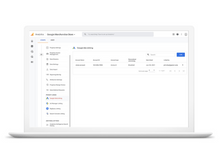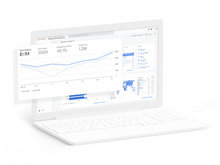When we talk about web analytics and user behavior tracking, Hotjar and Google Analytics are two prominent platforms that come to our mind. It caters to the needs of businesses aiming to understand and enhance their online presence. Both tools serve the common purpose of providing insights into user behavior, however, they differ significantly in terms of features, capabilities, and usability. Let's explore a comprehensive comparison between Hotjar and Google Analytics across various aspects. After this guide, you can easily tell which platform will be best for your specific web tracking requirements.
Hotjar and Google Analytics: Overview
Hotjar and Google Analytics are both powerful tools used by businesses to understand user behavior and optimize their websites.
Hotjar is a renowned product experience platform that provides behavior analytics and feedback data to help businesses understand their customers. It's designed for online businesses, and helps users understand how people interact with their website.
Google Analytics, on the other hand, is one of the most widely used web analytics platforms globally. It provides robust reporting capabilities with customizable dashboards. Moreover, it integrates with Google's marketing and advertising platforms, including Search Console, Google Ads, and Data Studio. GA can help organizations with website tracking, visitor insights, traffic sources and much more.
Hotjar vs. Google Analytics: Pros and Cons
- Overall, Hotjar's traffic analysis features are less comprehensive than Google Analytics. You won't get detailed insights into demographics, source channels, or user journeys.
- Google Analytics provides a wealth of data on website traffic compared to Hotjar. it includes demographics, source channels, user journeys, and device usage.
- Hotjar offers built-in survey and feedback tools to gather user opinions directly on your website. This feature is not available on Google Analytics.
- Hotjar is better than Google Analytics in providing visual representations of user behavior through features like heatmaps and session recordings.
Hotjar vs. Google Analytics: In Terms of Features
Both Hotjar and Google Analytics differ from each other when it comes to real-time reporting, data collection, conversion funnels, customizations and more. Here is a comparison between both in terms of features:
- Data Collection: Hotjar and some other Hotjar alternatives primarily focus on qualitative data. It helps you understand user behavior by visualizing their interactions. It offers features like Heatmaps, session recording, visuals etc. On the other hand, Google Analytics focuses on quantitative data. It provides statistics and reports on website traffic, demographics, and conversions.
- Real-time reporting: Hotjar offers some real-time insights, but they are not as comprehensive as Google Analytics. With this platform, users can see a basic version of heatmap with recent visitor clicks and scrolls. This can give you a quick glimpse into current user behavior on specific pages. On the surface, Google Analytics and a few Google Analytics alternatives offer a dedicated "Real-time" section that provides up-to-date data on various website activities. You can see the number of users currently on your website and traffic sources (search engines, social media, etc.).
- Conversion funnels: Google Analytics offers robust conversion funnel tracking. You can define specific goals (e.g., form submissions, purchases) and track users as they progress through the steps leading to that goal. It allows you to visualize drop-off points within the funnel, identify areas for improvement, and optimize the conversion process. While Hotjar can track user behavior on your website, it lacks dedicated conversion funnel functionality.
- Traffic Analysis: When it comes to analyzing the traffic, Google Analytics is a clear winner. Google Analytics offers a much richer picture of your website traffic. It offers details like source, demographics, user behavior & journey, and much more. Whereas Hotjar provides basic traffic data like page views and bounce rates but lacks the in-depth analysis capabilities of Google Analytics.
- Visualizing User Behavior: Hotjar is known for creating heatmaps, which are visual representations of user clicks, scrolls, and attention areas on webpages. These heatmaps reveal where users are focusing their attention, identify areas of high interest, and potentially uncover usability issues. On the other hand, Google Analytics offers limited heatmap functionality through integrations with other tools.
- Customization: Hotjar offers some basic customization options for its features. You can filter heatmaps by device type, visitor source, and other criteria. Surveys and feedback tools allow for some customization in question types and formatting. Moreover, you can't extensively customize the data Hotjar collects or the way it is presented. Alternatively, Google Analytics offers a wide range of customization options. You can create custom segments to analyze specific user groups, set up custom reports with the metrics and dimensions you care about, and use custom filters to exclude unwanted data.
Hotjar vs. Google Analytics: User Segmentation
Hotjar allows for basic user segmentation based on behavior captured through heatmaps and session recordings, but it may not offer the depth of segmentation options compared to Google Analytics.
Google Analytics offers robust user segmentation capabilities based on various dimensions and metrics, allowing for precise targeting and analysis of different user groups.
Hotjar vs. Google Analytics: Integration
Hotjar integrates with various platforms and content management systems, but its integration options may not be as extensive as Google Analytics. Google Analytics seamlessly integrates with other Google products such as Google Ads, Google Tag Manager, and Data Studio, as well as with numerous third-party platforms.
Hotjar vs. Google Analytics: User Interface
Hotjar provides a user-friendly interface with easy navigation, making it easy for users to access and interpret data quickly. Google Analytics, however, has a slightly complex interface due to extensive features. This may appear overwhelming for beginners, but it also provides in-depth analysis capabilities once users have full understanding of the tool.
Hotjar vs. Google Analytics: Pricing
Hotjar offers various pricing plans starting from $39 per month, with features like unlimited heatmaps, recordings, and responses. On the other hand, Google Analytics is free to use for basic features, but offers advanced features through Google Analytics 360, which is a paid product, and its pricing is available upon request.
Hotjar vs. Google Analytics: Customer Support
Hotjar provides customer support through its knowledge base, email support, and online resources, but may lack live support options. Google Analytics offers extensive online resources, community forums, and email support, with additional support available for Google Analytics 360 customers. Overall, Google Analytics has an upper hand over Hotjar when it comes to customer support and services.
Conclusion
Both Hotjar and Google Analytics offer valuable insights into user behavior and website performance, but they cater to different needs and preferences.
Hotjar excels in providing visual insights and user feedback tools, making it ideal for optimizing user experience. Google Analytics offers comprehensive web analytics features, making it suitable for businesses looking for more detailed data analysis and reporting capabilities.
Ultimately, the choice between Hotjar and Google Analytics depends on the specific requirements, budget, and preferences of the business.


 4 Ratings & 4 Reviews
4 Ratings & 4 Reviews






















